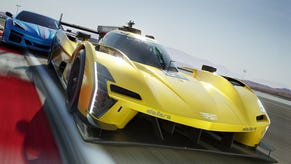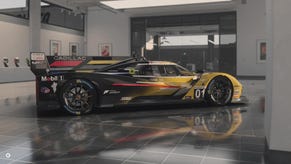Forza Motorsport tech review: a pleasing upgrade for series veterans
But ray-traced reflections fall short of expectations - and Microsoft's own marketing.
Six years and five days have passed since the release of Forza Motorsport 7, and Turn 10 Studios have been hard at work on a new entry in the beloved racing series. The simply-titled Forza Motorsport is an advanced track-based racer developed for PC and current-gen console hardware, emphasising advanced detail and sophisticated ray tracing effects.
It's an impressive effort, as John has detailed in his preview, but with the full version in hand, how do the game's 20 tracks hold up? How have the graphics been enhanced since the last series entry? And have we seen any notable improvements over the preview code?
Right from the opening, it's clear that Forza Motorsport is an impressive-looking racing game. There are intricate car models, detailed and well-lit tracks, with ray-traced reflections. There are a lot of great-looking track-based racing titles out there, and this is definitely one of the better-looking racing titles released in the current generation.
Perhaps the best place to start is by drawing some close comparisons with Forza Motorsport 7. FM7 was Turn 10's final foray on Xbox One hardware, and the new title clearly shows the advantages of crafting a game around a higher tier of hardware capability. The two games have 13 tracks in common, along with hundreds of shared cars, so there are a lot of comparison points to draw from.
Let's start with the most iconic track in Forza Motorsport history: Maple Valley. Here, there are enormous improvements made to foliage in this new entry, which is probably the most singularly-striking enhancement over the prior title. The foliage is complex and lit realistically, with subtle occlusion where the leaves are at their most dense and accurate self-shadowing. The old trees were simply two flat billboards intersecting at a 90 degree angle, so they didn't really interact properly with the game's lighting, with most lighting detail simply drawn into the foliage textures. With enough speed they looked fine enough, but they were clearly an area that needed considerable improvement - and the new Forza Motorsport delivers excellent results here. Turn 10 puts the fictional nature of the Maple Valley track to good use too, by placing lots of overhanging trees alongside the track edge, creating a more dynamic-looking track that highlights the reworked foliage.
The game's lighting in general also gets a big boost. Forza Motorsport 7 tends to have a flat appearance which looked unnatural in shaded areas. Its sequel typically has a richer lighting presentation, which is especially noticeable in complex areas like trackside stands. A lot of this stems from the game's ray-traced ambient occlusion (RTAO), which is present on the Series X version of Forza Motorsport in its performance RT and visuals modes. Global illumination also seems considerably enhanced, with the track and environment taking on a more natural hue through a range of lighting conditions. At times, these improvements produce a very striking image, with a dynamic lighting presentation relative to the earlier title.
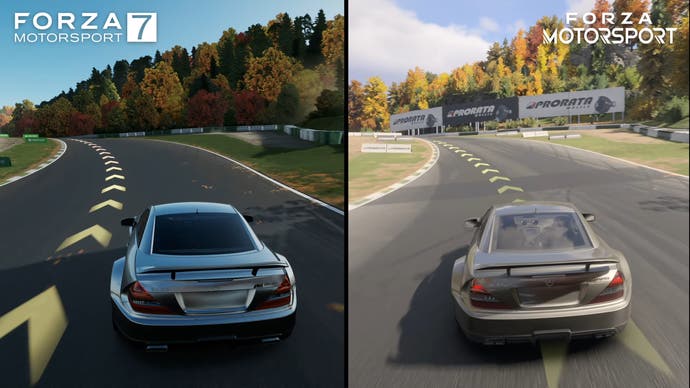
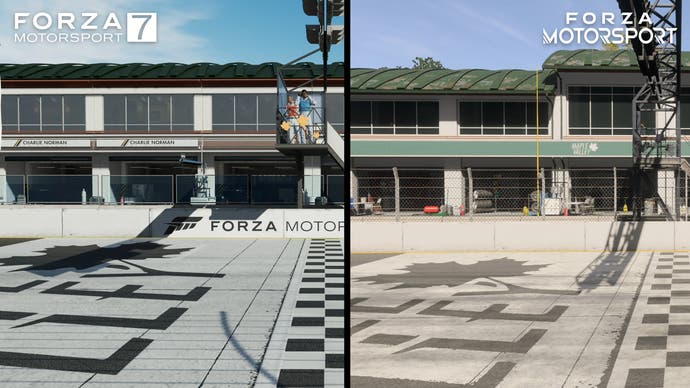
For this game, Turn 10 has transitioned from a more heavily precalculated lighting solution - which relied on baked AO and shadowmaps - to one that emphasises real-time versions of those techniques. As a result, races can now smoothly move through different times of day as they progress and each course features a range of starting times, time progression rates, and prevailing weather conditions. The new real-time shadows have their limitations, with moderate resolution and a reduced update rate - around 15fps in one example - but they do make the tracks a lot more flexible. The clouds have also seen a real-time transformation and are now volumetric, which is a big upgrade over the crude texture-based clouds we saw in Forza Motorsport 7. They still don't track properly with the movement of the player car though, and feel disconnected from your traversal of each circuit.
Each track is remodelled. The actual track surface used for gameplay is rescanned in many cases, and the trackside environment has seen a bit of a visual overhaul as well. Some of the temporary track adornments like these tents are upgraded, while others that have seen real-life upgrades, like Silverstone, are tweaked to reflect those changes. Generally speaking, the tracks do seem quite similar to their Forza Motorsport 7 counterparts in terms of geometry, but there have been some polygonal changes here, alongside improved lighting and materials work and the updated foliage. Some of the tracks still look a bit drab, though their real-world counterparts aren't exactly visually arresting either. Plus, the crowds are no longer simple 2D billboards and are actually real 3D models, though I did notice that the new crowds are almost always less dense than in FM7 - perhaps there's a performance trade-off there. The only big disappointment here is the texture filtering, which is very poor on consoles, with smeared detail on the track surface and on trackside barriers.
Forza Motorsport also pulls ahead in car rendering. The actual car geometry for returning cars is often quite similar to Forza Motorsport 7. Like Gran Turismo, the Forza games rely on a large library of car models which are used across multiple games and upgraded over time; polygonally speaking, these models seem very similar to their previous-gen counterparts. There are some definite tweaks and enhancements though, like the wheels, which have been remodeled. Select elements on the cars have also been tweaked, like their dashboards, which now are properly self-shadowed as well. Unfortunately, in photo mode non-player cars are still using a lower LOD, which makes this mode less useful.
The big change comes down to car materials, which are overhauled for this new entry. Carbon fibre looks appropriately glossy and reflects the sky's blue tint at an angle, while the differentiation between the metals, fabric, and plastics is more stark than ever. Textures are replaced and material properties overhauled, such that car interiors often look dramatically different than before - and much improved. Car paint also looks more correct to my eyes. Simulating car paint is very complex and it's hard to place exactly what's changed, but across a variety of lighting conditions I feel that Forza Motorsport looks subtly more "correct" than its previous-generation counterpart. I'm sure the RTAO plays a role here, as well as the improved reflections.
But let's move away from the Forza Motorsport 7 comparisons and move onto a more thorough discussion of those reflections, because they've been a source of some controversy in this title. Essentially, Forza Motorsport uses a mix of reflection techniques: cubemaps, screen-space reflections, planar reflections, and ray-traced reflections. The cubemaps are used for trackside reflections, and real-time cubemaps are also used for most reflections on the car bodies. Screen-space reflections show up on wet track surfaces, while planar reflections are used for in-game car mirrors in the cockpit view. Finally, ray-traced reflections can be found on car bodies for very reflective surfaces, but are only typically used for car self-reflections and for the reflection of other cars. Limited ray traced reflections are also visible during gameplay on some trackside surfaces while in the Visuals mode on Series X. During certain cutscenes, more exhaustive ray traced reflections are in use, however, as well as in the game's menus.
For those who have watched John's preview coverage (embedded below), the reflections seem generally unchanged from the preview code. Turn 10 have essentially blended a bunch of techniques together to get some key benefits of RT reflections - the ability to reflect dynamic objects and showcase self-reflection - without committing completely to a ray tracing solution that would likely prove very expensive for a 60fps game. It mostly works, especially when racing at high speed, but there are some notable flaws too.
The real-time cubemaps update at just 30fps, for one thing. This means that most of the in-game reflections look a bit choppy when the game is running at 60fps and look a touch awkward juxtaposed against the 60fps RT reflections. Forza Motorsport 7 also used 30fps reflections, so this isn't exactly an unprecedented compromise, but it would have been nice to get a 60Hz update here instead. The cubemap details do seem to be duplicated across cars as well - so you'll see overhead gantries flashing above all cars at the same time, even if they're on different parts of the circuit.
Moreover, early preview footage from the game - as well as some of the shipping game's real-time cinematics - showcase expanded RT reflections, with the environment displayed as well. This is where some understandable consternation online has erupted. It's a bit disappointing that we can't get these reflections in-game, even in the 30fps visuals mode on Series X or on the PC build. Again, what Turn 10 has shipped is totally fine, but expectations were set a bit higher with the game's promotional footage.
Forza Motorsport is a very good-looking racing game overall. Its last-gen predecessor isn't an ugly title by any means but the new entry comprehensively bests it from a visual perspective and lands among the better-looking track-based racers we've seen so far. The only real disappointment is that the underlying technology isn't being pushed as far as it seems it could be and how it was initially presented in marketing materials.

In my opnion, Series X in its performance RT mode isthe best way to experience the game on current-gen consoles. However, there are other graphical modes available on the Series X, while the Series S is its own kettle of fish.
On Series X there are three visual modes: performance, performance RT and quality. General visual settings are quite similar for all three modes, with the exception of ray tracing. The performance mode completely lacks RT, so you don't see any reflections of other cars while racing. The other visual modes include RT reflections on cars, which seem to be about the same quality in both modes.
Ray-traced ambient occlusion is also absent from the performance mode. RTAO makes a surprisingly big impact on the game's visuals, greatly improving car shading and vastly increasing the fidelity of the rendering of car interiors. In areas with complex geometry, the RTAO simply makes a huge difference. If you do look closely you can observe the RTAO denoising in action, but in general gameplay the results appear very stable. And across the Performance RT and visuals modes, the RTAO presentation looks substantially the same.
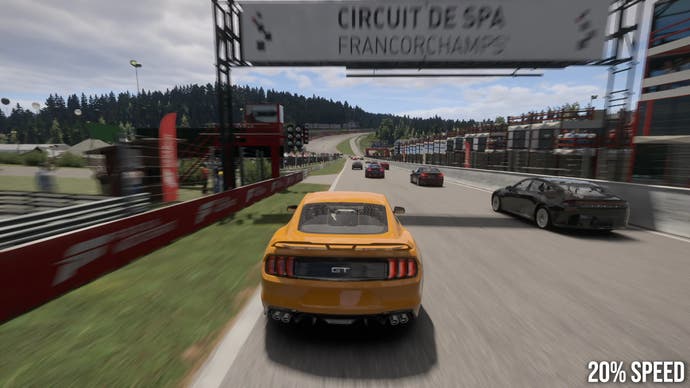
The only real fundamental settings difference between the performance RT and visuals modes is the addition of very limited trackside RT reflections in the visual modes. For example, a trackside barrier uses a basic cubemap in the Performance RT mode, while the visuals mode gets an RT reflection of the overhang as well. This is very rarely noticeable while racing, however. There's also a small improvement to real-time cubemaps in the visuals mode, as they display further into the distance.
On top of those settings tweaks, predictably there is a resolution difference between the three modes. In my testing across typical play, the performance mode's internal resolution is at about 2160p (full 4K), the performance RT mode averaged around 1584p, and the visuals mode came out at 2160p typically.
If we go back to Forza Motorsport 7 for a second, even the lowest-resolution mode in Forza Motorsport achieves significantly better image quality. FM7 is running at a full 2160p with 4x MSAA here, but fails to cleanly resolve fine detail and address specular aliasing. The overall image in Forza Motorsport is much more stable. It does exhibit some issues at times, but the switch to TAA has definitely paid off here.
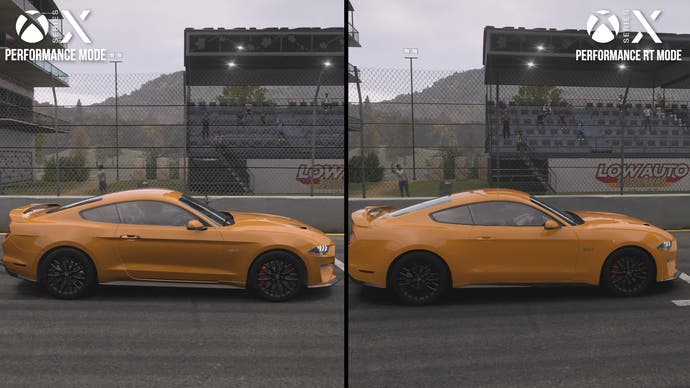
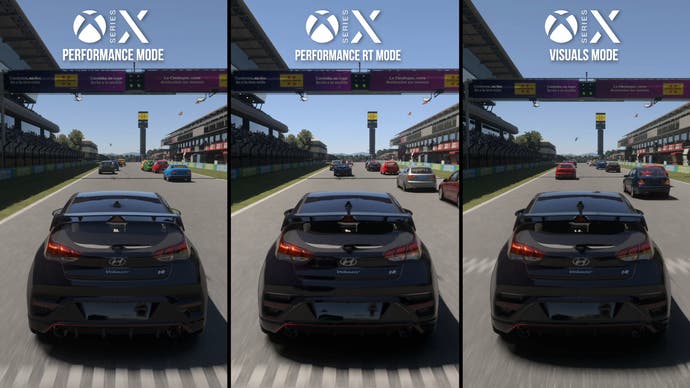
Series S packs two modes, called performance and visuals. Both lack all forms of RT during gameplay and replays, basically resembling the performance mode on Series X. This has a pretty big impact on the graphics unfortunately. There's not much between the two modes in terms of basic visual settings, but the performance mode does see some downgrades relative to the visuals mode, in the quality of real-time cubemap reflections and in foliage density.
The performance mode on Series S typically has an internal resolution of about 1080p, while the visuals mode is usually at 1440p. In direct comparisons against the Series X code, both modes on Series S look substantially blurrier and lack detail. The performance mode is particularly soft and doesn't fare well against the relatively sharp output on Series X. It's fair to say that the Series S is a bit of a disappointment in Forza Motorsport - the ray tracing is absent outside of the game's menus, and image quality is a lot worse than we see on its more powerful sibling.
Thankfully, both Series consoles manage a basically impeccable output in frame-rate terms. I tried my hardest to push the game, putting myself in the middle of huge grids on rainy, overcast tracks and driving very poorly. These are situations that reliably produce frame-rate dips in other racing games, but don't seem to have any effect here. Forza is just perfectly locked to its frame-rate target, so the game runs at a steady 30fps in the visuals modes and 60fps in the performance modes. Outside of gameplay, Forza Motorsport generally runs at 30fps, so all the game's menus and replays aim for and hit a flat 30fps update.
This is impressive stuff. Turn 10 has clearly calibrated the game around hitting high frame-rates consistently on console hardware, and to achieve 60fps gameplay with two RT effects on Series X is a bit of an accomplishment. It's a perfectly smooth experience, and the game's high-quality motion blur perfectly accentuates the flow of the action.
Personally, I'd stick with the performance RT mode on Series X and the performance mode on Series S. The 60fps update improves gameplay hugely, and the graphical losses relative to the visuals mode on either console aren't very significant. It's just too bad that the Series S has been totally stripped of ray tracing features, but at least it does manage to hold consistent frame-rates.
As a final note, I did encounter some glitches with Forza Motorsport while playing. The game crashed to the Xbox dashboard several times while I was testing and the game exhibited occasional issues like broken car reflections or flickering track surfaces. Forza Motorsport seems to have an issue with its gamma presentation as well, as the blacks take on a greyish appearance after you exit the visual settings menu without restarting. This was also a problem in the preview build, and it really does damage the look of the game. It's likely that these issues will be stamped out with the first few patches, as some of the problems from the preview build already seem to have been fixed for the final release, but the game is coming in a little too hot for comfort.
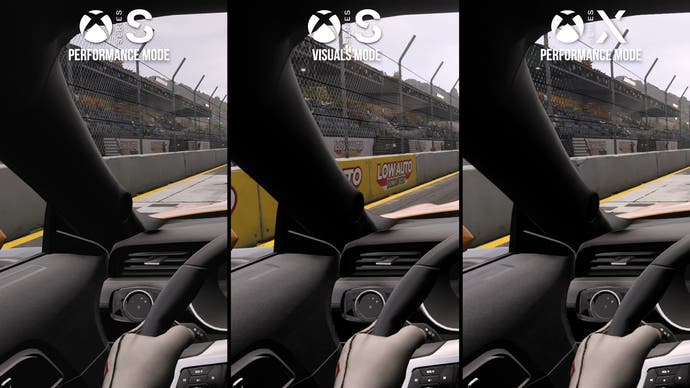

Forza Motorsport is a very good-looking game - and it plays well too. Like prior Forza titles it feels perfectly snappy and responsive on a console gamepad, with a lot of tuning options to suit players of different tastes and skill levels. The game has a "simcade" racing sensibility, and strikes a good balance between on-track realism and playability, veering slightly more towards the arcade side of things relative to recent Gran Turismo entries.
If you've played prior Forza Motorsport titles you'll mostly know what to expect here, though there are some interesting tweaks for this game. There's a detailed in-game penalty system with appropriate punishments for overtaking off-track and other infractions, which can be set to more lenient or harsher enforcement presets as you see fit.
I wasn't as much of a fan of the ability to pick your own starting position before each single-player race event, in lieu of qualifying or a set race start position. It's a lot easier to keep a car behind than to overtake, so starting in a good grid spot and holding back a queue of AI cars seemed like a strategy that was a bit too powerful. I'd prefer grid spots were assigned based on qualifying speed, or preset on a per-race basis to give players a healthy challenge.
That said, I've definitely enjoyed what I've played of the game so far and I think Forza Motorsport will prove pleasing to series veterans. The visuals are a big part of that appeal as well of course, and this entry is a substantial upgrade over Forza Motorsport 7, with much better lighting, greatly improved PBR materials, high-fidelity foliage and more accurate reflections. I'm not sure if it's the best-looking track-based racer out there, but it's certainly in the mix. You do get the sense that the game could be pushed harder though, at least on higher-end platforms, with the RT reflections falling short of expectations and the promised RTGI for PC totally absent, at least at launch. What you get doesn't disappoint, but I'd hope to see improvement from Turn 10 as the game matures.










